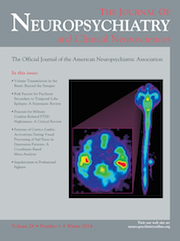Neuropsychological Functioning in a Patient With Primary Angiitis of the CNS
To the Editor: Primary angiitis of the central nervous system (PACNS), is a rare form of vasculitis restricted to the brain and spinal cord. The condition results in diffuse inflammation and destruction of small-to-medium sized blood vessels in the CNS. The clinical symptoms are nonspecific and reflect the diffuse nature of the pathological process. Headache is a common symptom. Other symptoms include cognitive impairment, stroke, transient ischemic attacks, cranial nerve involvement, myelopathy, seizures, and ataxia.1 Apart from reporting that cognitive deficits can be present, to-date no reports of cognitive and behavioral functioning in patients with PACNS have been published. Here, we describe the neuropsychological functioning of a patient with confirmed primary angiitis, at baseline and at 3 and 10 months of treatment with immunosuppressive medication.
Case Report
The patient is a 33-year-old Polish man who presented to the neurology department with recurrent epileptic insults (generalized tonic–clonic insults). Several months later, the patient presented to the emergency unit with a 40-minute episode of aphasia and numbness in his right arm. Repeated brain MRI showed fast, progressive, multiple cortical and subcortical micro-bleeding that included the basal ganglia. Neurodiagnostic tests and brain biopsy confirmed the diagnosis of a primary angiitis. Immunosuppressive treatment with cyclophosphamide was started. He was referred for neuropsychological testing to objectify cognitive dysfunction and progression during treatment.
Neuropsychological evaluation was limited because of the language barrier and was conducted with the help of a translator. The patient speaks only Polish. The Polish version of the Montreal Cognitive Assessment (MoCA)2 was used, as well as tests of attention, speed of information-processing, visual memory, visuospatial skills, and visuoperceptual organization. Results at baseline showed global cognitive impairment, with a MoCA score of 15/30. His cognitive profile revealed significant dysfunction with regard to processing speed, attention, and executive functioning. Auditory-verbal memory was severely affected; encoding of information as well as retrieval efficiency were disturbed. Constructional praxis, as well as visuospatial skills, were deficient. Naming was only mildly impaired. Apathy was reported. Performance at 3 and 10 months’ treatment revealed cognitive improvement, with an MoCA score of respectively 20/30 and 26/30. Although global cognitive improvement was found, speed of processing, aspects of attention, and executive functioning and memory were still deficient. At the behavioral level, the patient proved to engage more in household tasks and to be more talkative.
Discussion
This case shows that primary angiitis can cause severe global cognitive impairment and apathy, with language abilities being mostly preserved. Reevaluation during medical treatment indicates improvement of global cognitive function, especially with performance on language, constructional praxis, visuospatial skills, and visuoperceptual organization being normalized or mildly affected. Performance with respect to speed of processing, aspects of attention, and executive functioning and memory improved, but is still deficient. The initial results suggest that cortical as well as subcortical structures are involved in the disease. As recovery progresses, a major and more persistent dysfunction of fronto/subcortical systems is revealed.
1 : Primary angiitis of the CNS. Lancet Neurol 2011; 10:561–572Crossref, Medline, Google Scholar
2 : The Montreal Cognitive Assessment, MoCA: a brief screening tool for mild cognitive impairment. J Am Geriatr Soc 2005; 53:695–699Crossref, Medline, Google Scholar



